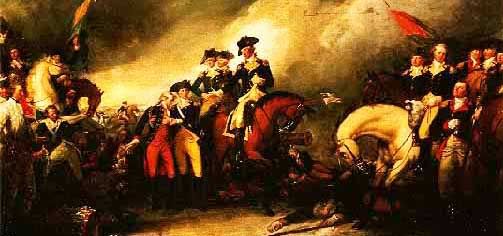 In doing research on Paul Revere's ride I came across this article from a Fredercksburg, Va.newspaper: "One of the real heroes of the Revolutionary War getting shortchanged at Mount Vernon's new $100 million museum and cultural center set to open in October? Hint: He was one of Gen. Washington's biggest supporters What about brave Old Nelson, who unflinchingly carried the future first president through British fire during the Revolutionary War?A horse is a horse, of course, of course. But when a horse is a hero, shouldn't the horse get credit?This fall, George Washington's Mount Vernon Estate & Gardens opens a $100 million addition--including an orientation center, museum and education center--that will employ advanced forensic science to change our first president's image from the dour, toothless old man on the dollar bill to what James C. Rees, executive director at Mount Vernon, is calling Washington "America's first action hero."In the process, Mount Vernon officials have chosen to put the sexier Washington astride a sexy horse. A First in War Gallery will show the Revolutionary War general mounted on Blueskin, a white stallion that artists over history have generally regarded a more studly horse than Nelson. But it was Nelson whom Washington himself credited with carrying him through most of the British fire he encountered during the Revolutionary War.Good guys ride brilliant white horses. Sidekicks ride horses that look like Nelson. The Lone Ranger rode Silver and Roy Rogers rode Trigger. Tonto's and Dale Evans' rides? Scout and Buttermilk were horses of a different color.There's some debate over which horse Washington rode at Valley Forge, the moment in time portrayed in the gallery. There's no debate, however, that Nelson was the more noteworthy steed, even if his coat was dull.
In doing research on Paul Revere's ride I came across this article from a Fredercksburg, Va.newspaper: "One of the real heroes of the Revolutionary War getting shortchanged at Mount Vernon's new $100 million museum and cultural center set to open in October? Hint: He was one of Gen. Washington's biggest supporters What about brave Old Nelson, who unflinchingly carried the future first president through British fire during the Revolutionary War?A horse is a horse, of course, of course. But when a horse is a hero, shouldn't the horse get credit?This fall, George Washington's Mount Vernon Estate & Gardens opens a $100 million addition--including an orientation center, museum and education center--that will employ advanced forensic science to change our first president's image from the dour, toothless old man on the dollar bill to what James C. Rees, executive director at Mount Vernon, is calling Washington "America's first action hero."In the process, Mount Vernon officials have chosen to put the sexier Washington astride a sexy horse. A First in War Gallery will show the Revolutionary War general mounted on Blueskin, a white stallion that artists over history have generally regarded a more studly horse than Nelson. But it was Nelson whom Washington himself credited with carrying him through most of the British fire he encountered during the Revolutionary War.Good guys ride brilliant white horses. Sidekicks ride horses that look like Nelson. The Lone Ranger rode Silver and Roy Rogers rode Trigger. Tonto's and Dale Evans' rides? Scout and Buttermilk were horses of a different color.There's some debate over which horse Washington rode at Valley Forge, the moment in time portrayed in the gallery. There's no debate, however, that Nelson was the more noteworthy steed, even if his coat was dull.A question of proof
Mount Vernon researchers say they have no choice but to go with the flashier but apparently faint-hearted Blueskin--who supposedly cowered before musket and cannon fire--because they can't prove Nelson was at Valley Forge during the winter of 1777. But Shannon Leva, of the International Museum of the the Horse in Lexington, Ky., sided with the boring-looking-but-brave Nelson. Leva cited the "The Book of Famous Horses" by Caroline Ticknor, which says Washington had Nelson as early as 1775--two years prior to Valley Forge. Emily Coleman Dibella, a spokeswoman for Mount Vernon, said Ticknor's nearly 80-year-old account, written in the style of a novel, can't be confirmed as a scholarly work.The IMH Web site goes out of its way to defend Nelson's honor."Nelson survived the rigors of near-starvation at Valley Forge and relentless marches from Boston to the Carolinas," and remained Washington's favorite through his first term as president, the Web site says."He, too, remained 'first in war, first in peace'--if not first in the memory of history," the horse museum Web site says, taking a swipe at 18th- and 19th-century artists for emphasizing aesthetics over true heroism.Mount Vernon commissioned advanced technology to produce true-to-life images of Washington as a 19-year-old surveyor, 45-year-old Revolutionary War general and 57-year-old president. Those figures are expected to be the focal points of the new Donald W. Reynolds Museum and Education Center set to open Oct. 27 at Mount Vernon. A recent sneak media preview of the project indicated Rees probably will succeed with a project that depended on the latest in high-tech forensic science. But in the process of making Washington look heroic, has an injustice been done to one of the true heroes of the war? Leva says that over the century following the Revolutionary War, painters tended to portray Washington astride Blueskin because "a white horse appears more regal than a chestnut and has a certain connotation" of the American "good guy" on the white horse."
All of this inspired me to create a slide show of famous war horses.






No comments:
Post a Comment